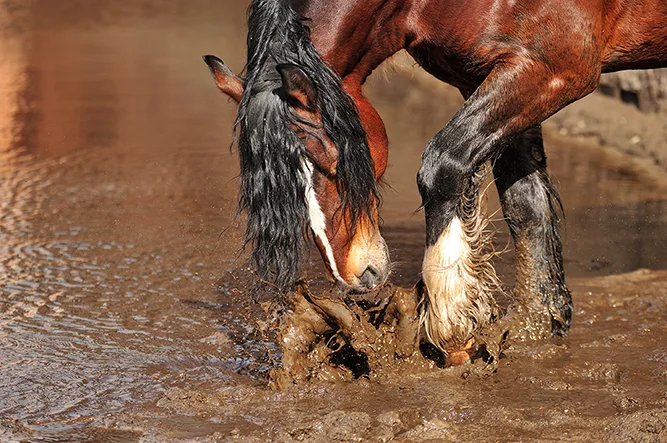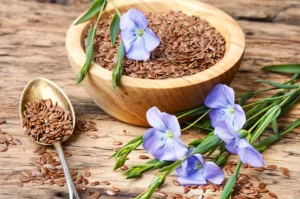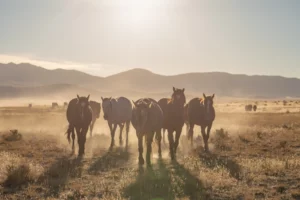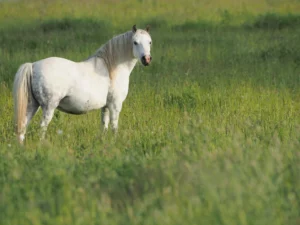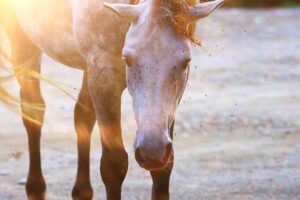Introduction
While the sun is shining and the pleasant weather lures you in, contemplating winter may not be your top priority. However, once the mud and frost season begins, you may find yourself regretting not having made better use of the summer to prepare the horse turnouts for winter. That’s because when the horses are struggling in the mud, the days are short, and the weather is miserable, you won’t be motivated to carry out construction measures that could simplify your life. Hence, summer is indeed the opportune time to plan ahead and ready the stable for the upcoming frost and mud season.
Pave turnouts
Simply said, but not always easily done. Elaborate paving with professional drainage and similar projects often become impractical for temporary tenants or those without access to savings. Nonetheless, it’s possible to simplify your life during the mud season. For example, you can install paddock slabs on pathways within the turnout. These are also available in variants that don’t require subfloor fastening. It only needs to be somewhat leveled, and during the summer, this can typically be achieved effectively using a tractor, car, or even a horse-drawn drag. Paving the entire paddock is not necessary.
Horses tend to use walking paths to navigate the turnout area while keeping their feet dry. Consequently, manure often accumulates along these paths and can be readily collected.
Implementing trail corridors can significantly streamline the mucking out process. These corridors encourage horses to cover more ground, but at the same time, the manure isn’t dispersed across extensive muddy areas; instead, it remains concentrated on or near the pathways.
Paving the ground especially around feeding areas is essential, as these spots tend to become exceptionally muddy. Grass pavers can also be a suitable option, but it’s important to fill the holes properly to prevent ponies and foals from getting stuck in them. You can also occasionally find used football turf at an affordable price, and it works exceptionally well, especially on uneven surfaces. Its weight also means that it doesn’t need to be surfaced much, except on slopes. With dry standing areas around the hayracks and paved walkways, mucking out in winter becomes much more manageable. Additionally, dirt-related diseases in the leg area, such as thrush or mallenders, cannot develop as easily.
Design water drains
Horses don’t mind walking through mud sometimes. However, especially in very wet winters with temperatures above freezing and heavy rainfall, it can become quite unpleasant in many paddocks. Not only do our own wellies tend to get stuck on our way to our horses, but the wheelbarrow can also be difficult to maneuver. Additionally, standing constantly in mud contaminated with feces is neither healthy for the hooves nor for the skin on the legs of our beloved animals.
If you have turnouts with slopes, you are usually in a good position because the water largely drains away on its own, although the slope may gradually erode over time. In contrast, turnouts in flat areas tend to become more waterlogged to varying degrees, depending on the amount of rainfall. Without proper drainage, the paddock slabs may eventually shift or sink into the mud, reminiscent of Atlantis sinking into the sea.
To avoid having to embark on archaeological excavations for your paddock slabs in the spring, it’s advisable to take action against potential water flooding now. This can be done by digging ditches or constructing embankments to redirect water to areas that horses do not use frequently or even at all.
The ditches and mounds should ideally be located outside the areas that horses frequently use, as horses tend to enjoy climbing over mounds that have been filled in or rolling around in ditches. They can quickly undo the painstaking earthworks and level everything again in a short amount of time.
Here as well, it is beneficial to create pathways and then redirect the water away from these pathways to less frequented areas. For instance, you can fill in the pathway and then reinforce it with paddock slabs in the center. This enables the water to flow to the sides and continue draining from there. The horses (and the wheelbarrow) will then stay dry in the middle on the “ridge”.
If you lack any slope, consider excavating a pit outside the turnout or within it (while ensuring it’s well fenced off). This pit can serve as a drainage area for water collection. To further divert the water away from the turnout towards the field or the nearest ditch, you can use a pump and a long hose. This helps manage excess water effectively.
Of course, all these measures are not as optimal as having a turnout with professional drainage and surfacing, but they are still better than having everyone sinking into the mud during constant winter rain.

Keep drinking trough frost-free
One major issue in sub-zero temperatures is the freezing of water troughs. In stables, the problem is usually solved by installing a heated drinking system while keeping the windows and doors tightly closed. While this keeps the water liquid, horses in these stables often suffer to some extent from respiratory problems due to the continuously poor air quality. Water supply becomes even more challenging in open yards, as the watering troughs in such environments are naturally not insulated from the temperature of the surroundings.
If you have access to a frost-free water connection in the turnout, you are well-equipped with a heated automatic waterer. However, to operate this, you’ll also need an electrical power connection in addition to the water pipe. This setup may not be available in every open yard, or it may not be located where you want to install the drinking trough.
If you have a well, a watering trough with a ball is a good option.
Ball drinkers are often frost-free when you have more than four horses. Note: There may be differences between models; if unsure, consult the dealer or manufacturer for guidance. However, some horses have a tendency to “play” with the water at the trough, taking it into their mouths and then letting it flow out generously. This way, food particles can get into the trough, leading to potential germ growth. As a result, it’s essential to disassemble and clean these watering troughs regularly.
If you don’t have a well, a limited budget for a ball watering trough or a heated floater, or if you have fewer than four horses, a basic bathtub could serve the purpose equally well. This can be placed inside a wooden box and insulated using materials such as polystyrene or similar insulating material.
You can install a heating element, similar to the type used in terrariums, around the tub and connect it to a power supply. Others have also successfully installed an aquarium heating rod in the water, but in this case, you should look for a version with a dry fuse that switches off automatically if the rod is no longer surrounded by water.
Installations with one (or, in the case of large tubs, several) 60-watt light bulbs under the tub have also been successfully used, as they generate enough heat to keep the water warm.
If you lack electricity in the barn, you can also place candles under the tub, which will provide warmth from below with their candle heat. Be cautious, as most insulation materials are flammable! In this case, it’s essential to ensure a safe construction to prevent accidents and maintain a sufficient distance from the insulation to avoid fire hazards. A system that may not be as budget-friendly but is highly frost-proof is the ThermoBar from Sweden (where they certainly know about frost!). It comes in options with or without a power connection.
For anyone considering making their own heated watering trough, it’s best to start the project when the weather is still warm. You wouldn’t want to be working on it in sub-zero temperatures or continuous rain, as it could get quite messy.
Many horses, especially those with stomach ulcers, appreciate having access to warm water during the winter months.
If you arrive at the stable in the evening, it can be helpful for horses with stomach ulcers to bring warm water in canisters and allow them to drink to their satisfaction from buckets. In these cases, sometimes 20 litres or more are consumed by a single horse in one go. These horses can typically handle the occasional sips of cold water they drink during the day without experiencing constipation or kidney problems. When temperatures drop to -10°C and below, you may need to allow the horses to drink their fill from buckets of warm water in the morning and evening if other solutions are not effective. They quickly learn to drink as much as possible during the times when water is available so that they can stay hydrated during the periods without water access. Indeed, providing warm water during the colder months can help ensure that horses stay hydrated, which is crucial for their health and well-being. It’s important to adapt their water supply to the weather conditions to prevent issues related to frozen water sources.
Shorten distances
In the summer, when the weather is pleasant, we don’t mind taking a detour or two with the wheelbarrow full of manure. However, when it’s drizzling and the landscape is muddy, each additional walk becomes a form of torture. It’s worthwhile to plan ahead and consider where pathways can be optimized. Of course, you want to encourage the horses to move and, therefore, install as many hay feeding stations as possible. But if you have to carry loads of hay over muddy turnouts, the paddock trail can quickly become a Sisyphean task.
It is ideal if you can install multiple covered hayracks, load them with whole (round) bales, and secure them with a net to prevent the hay from being consumed too quickly. Regularly refilling them with a front loader is the simplest approach. However, not all stables have access to a front loader or can accommodate multiple hayracks due to their limited resources and number of horses. As a result, hay nets are often used, which, while effective, require more effort to fill.
Strategically placing small pasture tents or shelters stocked with hay bales near each hay station can be an effective solution.
Indeed, this approach can significantly reduce the distances you need to cover when feeding the horses, making it more convenient and efficient, especially in challenging weather conditions. Indeed, keeping pathways accessible in all weather conditions is essential for the efficient management of feeding stations, especially during wet and muddy seasons. Rolling hay bales through slush or mud can be labor-intensive and impractical, so proper planning and maintenance of pathways are key to ensuring that your horses receive adequate nutrition without unnecessary hassle. Preparing hay nets in advance and stocking them in the hay shelters over the weekend can significantly reduce the time and effort required for daily feeding during the workweek. This approach ensures that your horses have a consistent supply of hay without the need for daily preparation, making it a convenient solution for both you and your equine companions.
The location of the manure pit is indeed an important consideration for convenience and efficiency in stable management. Balancing the location of the manure pit to minimize odors and flies in the summer while considering accessibility in the winter is indeed a challenge.
Collecting manure in a heap on the turnout can be unfavorable in terms of hygiene and worm contamination. It’s important to maintain good manure management practices to minimize these issues. Consider placing a dedicated container or trailer on-site for regular manure disposal.
Ensure that the access to this area remains passable, as ground conditions may not always be dry or frozen when it’s time for collection.
A frost-proof, pre-filled water barrel can significantly reduce the need for manual water bucket transportation. Equipment, wheelbarrows, etc. should be easily accessible and designed to withstand various weather conditions. It can be quite inconvenient to dig equipment out of the snow or search for it in the twilight.
Ensure hay feeding
During the grazing season, you typically don’t need to be concerned about this, as the horses usually receive hay only at night or are on the pastures round the clock. However, by September at the latest, most stables need to resume feeding because the pastures have been depleted. To ensure an adequate supply of good hay, it’s advisable to communicate with farmers during the summer to determine the quantity required.
Horses typically consume 2-3 kilograms of hay per 100 kilograms of body weight per day.
As the weather gets colder, horses may require a greater amount of hay to meet their nutritional and energy needs. It is advisable to purchase an ample supply of hay rather than risking having too little. Experience has shown that prices tend to increase at the end of winter when supplies are running low. Hay serves as the primary source of warmth for horses, so it’s crucial to provide them with continuous access to roughage, especially in cold weather. The nightly mash meal is comforting for our peace of mind, but unfortunately, it doesn’t assist the horse in maintaining its warmth.
Many farmers offer the option of reserving winter stock and having it delivered in manageable quantities, so you don’t have to store hay for the entire winter. Storage under fleece or in a shelter or hay tent is suitable for small quantities and short-term needs. Avoid storing hay under a tarpaulin, as it can lead to condensation and promote mold growth. Storing hay under a tarpaulin is a short-term solution, and it can become quite tedious to retrieve hay bales from under layers of snow and ice. Setting up a small shelter or tent is always a worthwhile investment. Be sure to place 1-2 layers of pallets under the hay bales to provide ventilation from below and prevent the growth of mold.
When purchasing hay, ensure that the quality is suitable for the horses’ needs. It is common knowledge that moldy hay is not suitable for feeding at all. However, the nutritional values are often overlooked, and these are not visible on the outside of the hay. If you have a regular supplier, it is often worthwhile to conduct a hay analysis. The Weende analysis, along with sugar values, provides a comprehensive overview of the hay’s nutritional content. For leisure horses, it’s important that sugar levels are kept below 10%. However, for horses with metabolic issues like insulin resistance, EMS, pseudo-EMS, or PSSM, it’s even more crucial to ensure that sugar levels are below 6%. Low protein values in hay can be effectively supplemented with sainfoin cobs or Vitalcobs. Additionally, the hay should have a stalky texture, be light green in color, and emit a pleasant to neutral odor. A musty, sour, or fermented smell, significant dust formation, the presence of grey spots in the hay, or the presence of poisonous plants are clear indicators that the hay is absolutely unsuitable for feeding.
Feeding hay in racks with netting, hay nets, hay boxes, hay bins, hay balls, or other slow feeder methods extends the feeding time and ensures that horses have access to roughage continuously. Implementing various slow feeders in different locations within the turnout also encourages movement and allows horses to adopt different head and feeding postures, promoting natural behavior. By adding straw nets, branches, twigs, or even an armful of leaves, you can provide a variety of roughage options for your horses.

To ensure a consistent supply of nutrients during the winter, consider offering fat-containing seeds such as linseed, sunflower seeds, whole rose hips, and OKAPI Wild Seeds in rotation, in addition to providing salt licks and mineral feed. Dried berries, such as OKAPI Wild Berries or those collected in summer and dried for winter feeding, can provide high-quality vitamins even during the barren season. Blueberries, rose hips, raspberries, and blackberries can all be offered as dried berries for added nutrition during the winter months. During drying and storage, it’s crucial to ensure that no mold forms on the berries to maintain their quality and safety.
Conclusion
Preparing winter turnouts is essential for ensuring a stress-free experience for horse owners during the upcoming frost and slush season. Surfaced turnouts, well-planned water drainage systems, frost-free watering troughs, optimized pathways, and safe hay feeding methods are crucial measures to prioritize the health and well-being of horses during the cold winter season.
Implementing these measures will ensure our four-legged friends stay in good shape throughout the upcoming winter!
Article published on 15.07.2022
More tips: 9 productive activities for rainy days in the stables
- Linseed in Horse Feeding - 28. January 2025
- Organic Selenium and the “Rebound Effect”: Risks of Supplementing Selenium - 15. November 2024
- West Nile virus infections in horses - 10. September 2024

